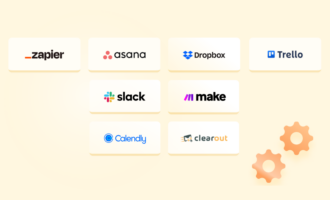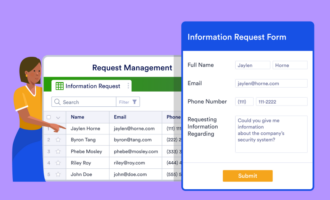Administrative tasks to automate
- Time tracking
- Scheduling
- Proposal writing
- Customer data management
- Invoice tracking
- Expense management
- Project management
Administrative tasks exist in every organization. They include everything from managing calendars and preparing documents and proposals to answering calls, arranging meetings, sending emails, and so much more. While these tasks are crucial to running an organization effectively, they’re often repetitive and tedious. This is why administrative automation is becoming increasingly popular.
The basics of administrative automation
Administrative automation is all about using technology to simplify or streamline administrative tasks. It’s a broad term that can refer to anything from a simple autoresponder for customer emails to an enterprise-wide system that manages complex business processes and workflows.
While administrative automation isn’t a new concept in the workplace, it’s become more popular in recent years due to technological advancements in artificial intelligence and machine learning. Automating repetitive and low-level administrative tasks can make work easier and boost productivity. Gartner predicts that by 2024, 69 percent of day-to-day managerial work will be entirely automated. So this is a great time to start exploring administrative automation.
If you’re looking for inspiration — or simply don’t know where automation could be most helpful — below are seven common administrative tasks you can start automating today.
7 common administrative tasks to automate
1. Time tracking
Tracking the amount of time employees work helps businesses understand employee performance and serves as the basis for compensation for hourly workers. Manual or paper-based time tracking can be tedious, time-consuming, and prone to errors, which is why this task is a good candidate for automation.
Jotform provides an employee timesheet template that makes it easy to track employee hours. You can customize the form to collect relevant information, including photos and attachments, and make it accessible to employees to record their hours. Weekly working hours, total hours, and overtime for each employee are then automatically calculated based on the information your employees provide.
2. Scheduling
Determining employee availability, managing time-off requests, and assigning shifts makes scheduling a challenge for managers. Plus, manually tracking schedules limits how much time they can spend on more productive tasks.
Fortunately, you can fully automate scheduling. With Jotform’s employee schedule template, you can set up a schedule request form that automatically populates the employee schedule sheet with their responses. You’ll end up with a custom template that also helps you track employee schedules, days off, and hours worked.
3. Proposal writing
For many organizations, drafting custom sales proposals from scratch is a time-consuming but necessary activity. While you can’t automate the entire process — because you still need to tailor your business proposals to each situation — a little automation can take most of the sting out of the process. One way to introduce automation is to use a proposal generator.
With Jotform’s free proposal generator, you can draft winning proposals in minutes. First, choose any of Jotform’s free proposal templates and style it to match your company branding and use case. The next time you need to send a proposal, simply fill in key details in the proposal form, and you’ll get an automatically generated PDF proposal. You can also send the proposal directly to the recipient to sign electronically.
4. Customer data management
As a business grows, it often becomes difficult to manually track customer information. Automating your customer data collection and management helps you find information at a glance and prevents data loss.
With Jotform’s free customer relationship management templates, you can easily track customer data and view all interactions with your business in an easy-to-read spreadsheet. Simply link your contact or lead generation form to the spreadsheet to automatically populate it. You can easily customize the template to suit your use case, and you can access the data you collect on any device.
5. Invoice tracking
Managing invoices can quickly become chaotic, especially as the volume of transactions increases and fulfillment times diverge. Using an invoice tracking system can greatly ease the process.
For example, Jotform’s fully customizable invoice tracker template allows you to track invoices in an online table that you can also view as a calendar, spreadsheet, or easy-to-read card. You can auto-populate the spreadsheet by filling out the form attached to the template. Jotform also integrates with over 100 third-party platforms, including Stripe and PayPal, so when a customer makes a payment, the spreadsheet will automatically update.
Matthew Dailly, managing director of Tiger Financial, also recommends automating invoice reminders. “Most software programs let you establish automatic reminders for when invoice payments are due, while some even allow you to set up an early reminder so that your client won’t be surprised by your invoice,” he explains.
6. Expense management
Budgeting and expense management are crucial but tedious administrative tasks that your team has to tackle on a regular basis. No matter the type of budget involved, automating the process makes things easier.
For example, Jotform’s expense management templates are secure spreadsheets for tracking expenses and monitoring budget expenditures. You can automatically populate the spreadsheet by filling out the form linked to the spreadsheet template. Templates also come with a quick calculation feature that automatically adds up totals and helps you stay up to date on expenses.
7. Project management
When you’re managing a project, reaching out to every team member for updates can take up a lot of time, especially if you’re working with a large team or handling several projects.
While you can’t automate every aspect of project management, Jotform’s customizable project management templates allow you to stay organized by tracking all projects and tasks in one place using a powerful spreadsheet. You can auto-populate the spreadsheet using the attached form in the template and filter tasks by due date, assignee, priority, or any other custom metric.
Tips for effective administrative automation
To make sure your automation efforts are successful, keep the following tips in mind.
- Have a clear goal. Kimberley Tyler-Smith, head of marketing at Resume Worded, says it’s important to fully understand what you’re trying to automate. “Is it going to save time? Will it help increase productivity? Or will it allow for more accurate data collection?”
- Know what not to automate. Katy Smith, product manager of Airgram, says too much automation can take the personal touch out of your business.
“Automation may sound savvy and effective, but it isn’t a one-size-fits-all for every task that feels drab within the workplace. Automating tasks that are simple and common helps your business to be more effective. However, avoid automating tasks that naturally benefit from human interaction — this could be specific sales or customer service tasks,” Smith says.
- Have a backup plan. What happens when your automation fails? Andrew Gonzales, president at BusinessLoans.com, says it’s essential to create a contingency plan in case things go wrong. “When certain tasks don’t go as planned, manual intervention can prevent the situation from escalating. When those same tasks operate autonomously, and without oversight, there’s a greater consequence when errors occur,” Gonzalez explains.
Photo by Csaba Balazs on Unsplash





















































































Send Comment: